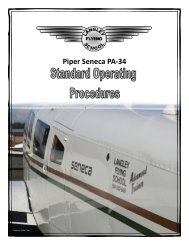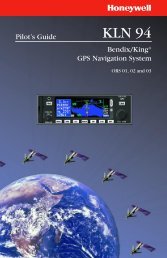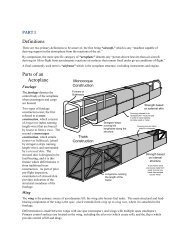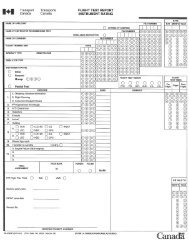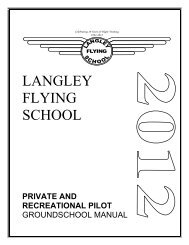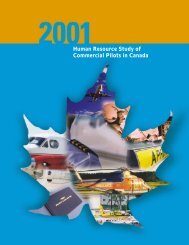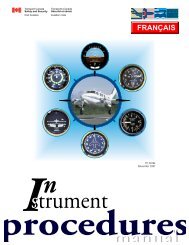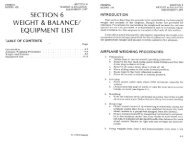LANGLEY FLYING SCHOOL Flight Training Handbook
LANGLEY FLYING SCHOOL Flight Training Handbook
LANGLEY FLYING SCHOOL Flight Training Handbook
You also want an ePaper? Increase the reach of your titles
YUMPU automatically turns print PDFs into web optimized ePapers that Google loves.
<strong>Flight</strong> <strong>Training</strong> <strong>Handbook</strong> Page 50<br />
Langley Flying School, Inc.<br />
initiating a climb or descent.<br />
Clearing Turns during Climbs<br />
You are especially vulnerable to mid-air collisions during a climb, the reason being that forward visibility is<br />
obscured by the engine cowling. For this reason, once the aircraft departs from the circuit (climbs through 1000’<br />
AGL), you should begin a series of gentle turns, left and right, so that the blind spot is cleared. To do this, use 15<br />
of bank, and turn to a heading approximately 30 (to turn further serves no purpose, and turning to a lesser heading<br />
will not clear the entire blind spot. To keep on track, the second clearing turn should be done in the opposite<br />
direction. During a climb, a clearing turn should be performed approximately every 30 seconds. While you are<br />
encouraged to turn frequently during a climb, do so smoothly and gently.<br />
For the first 1000’ of the departure from a runway, a clearing turn cannot be performed (unless you feel traffic<br />
circumstances warrant it), so before you apply power for takeoff, scan the departure end of the runway for potential<br />
traffic hazards—if you see one during the initial climb, manoeuvre to protect your safety.<br />
BIRD STRIKES<br />
Langley Flying School students are prohibited from conducting a takeoff or landing when birds are present on the<br />
runway (see P. 34 regarding <strong>LANGLEY</strong> <strong>FLYING</strong> <strong>SCHOOL</strong> FLIGHT RULES AND SAFETY<br />
PRECAUTIONSError! Bookmark not defined.). Here are some facts related to bird strikes that are worthy of<br />
remembering:<br />
1) Since 1912, 200 deaths have resulted from bird strikes on aircraft.<br />
2) The greatest risk is in flight below 2,500’ where 99% of all bird strikes occur.<br />
3) The faster the aircraft the greater the risk—up to 80-90 KNOTS, birds have time to get out of the way.<br />
4) The greatest risk is during March and April, and during September and October, when bird migration<br />
occurs.<br />
5) If you see birds ahead of you attempt to pass over, rather than under, as birds dive downward when<br />
threatened.<br />
6) Small birds such as Starlings are highly manoeuvrable and can effectively get out of the way; larger birds<br />
such as ducks, geese, or seagulls, present greater risk. 52<br />
7) Never takeoff or land when large birds are on the runway; instead conduct a low pass in an effort to get<br />
them to move on, in the case of landing, or back-track along the runway before taking off.<br />
8) Anticipate that a bird striking the windscreen will penetrate; use the instrument panel as a shield, anticipate<br />
blood and guts, and remember to fly the aircraft.<br />
9) All bird strikes are to be reported; see the RAC Section of the AIM.<br />
52 Remember, that when in close proximity to the ground, very little if any effort should be made to avoid birds—the speed of the aircraft is slow<br />
and the birds will manoeuvre to get out of the way. In contrast, birds are ineffective in avoiding aircraft when they take off from the ground to<br />
the air, and for this reason a landing or takeoff by an aircraft should never be conducted when there is a risk of contact with birds on the ground.<br />
2012 David L. Parry



